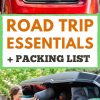89 Road Trip Packing List Essentials for Hitting the Road
This post may contain affiliate links.
Long stretches of open highway, a sense of total freedom, good tunes, an epic adventure at your fingertips… the road trip is a classic travel experience for good reason! In this post, you’ll find all the essential items for your road trip packing list to help you plan your trip.
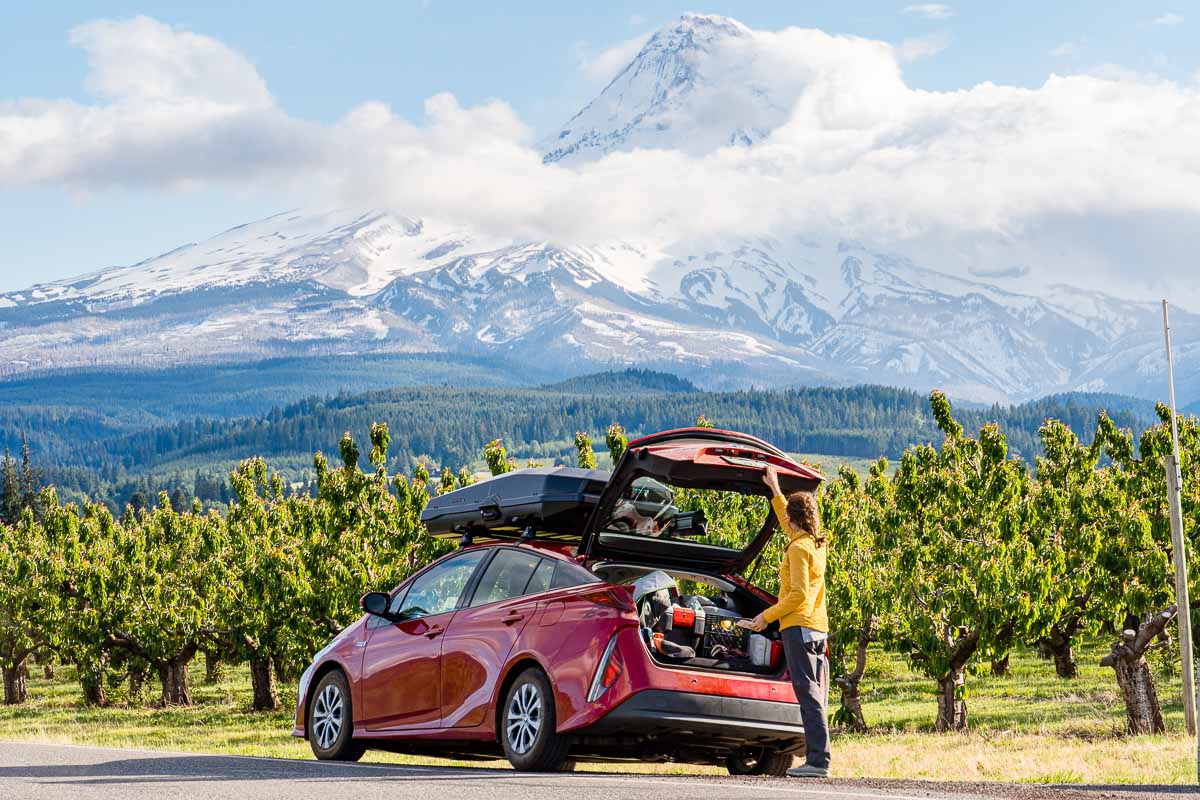
Written in partnership with Toyota
Michael and I have been taking road trips together for nearly a decade—from weekend jaunts to a year-long exploration of North America—so we’ve had thousands of miles to dial in our road trip essentials.
If you’re feeling the itch to hit the road, this post is for you! We’re sharing our complete road trip packing list with everything you need for a comfortable, fun, and safe road trip. A little planning and preparation go a long way so that once you start cruising down the highway, all you have to do is let the adventure unfold.
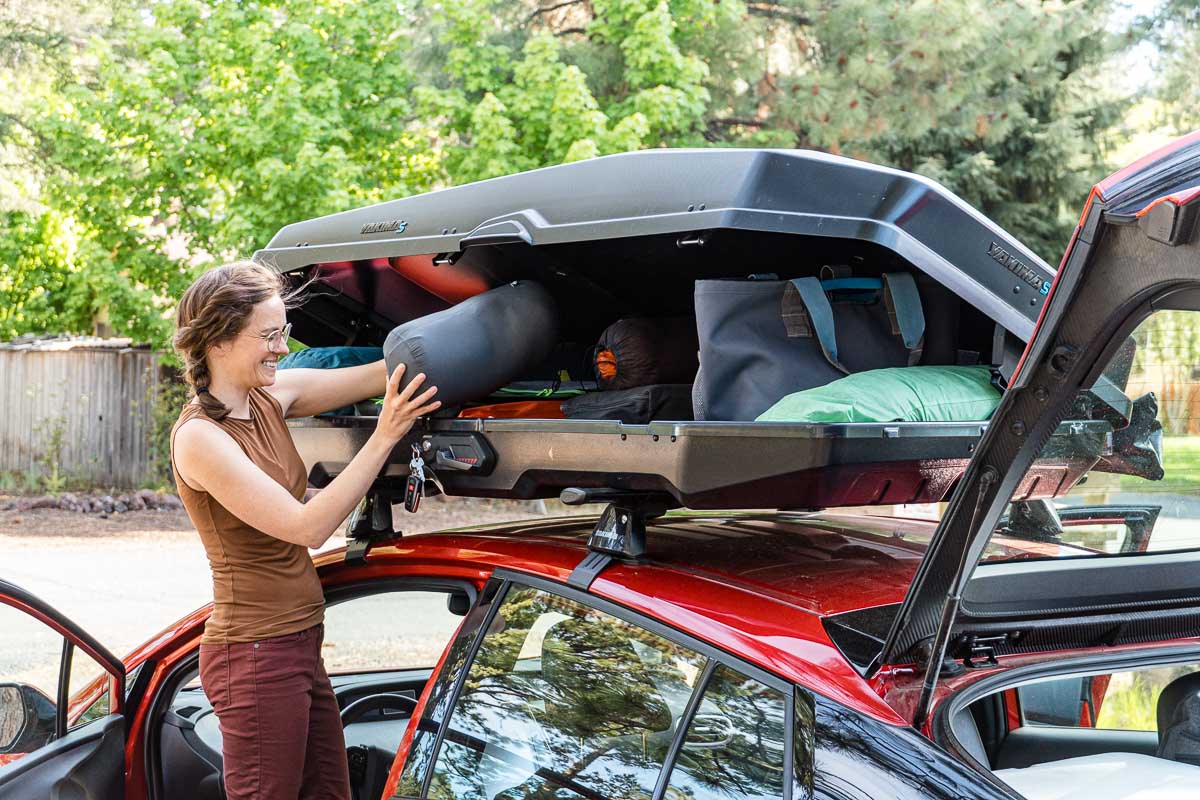
Before you go…
Bring your vehicle to a mechanic for a pre-trip inspection
If your vehicle has given you, shall we say, “cause for concern” in the past, then it might be worth bringing it to a mechanic for a pre-trip check before embarking on an extended road trip.
We often bring our vehicles in to our local Les Schwab Tire Center before a big trip to have them check the state of our brake pads. This is offered as a free service and most mechanics will offer something similar.
Quick Home Maintenance Check:
- How do the treads on the tires look?
- Are your tires at the proper pressure?
- When will you need another oil change?
- Is the windshield wiper fluid topped off?
Clean your car
The cheapest and easiest way to improve the quality of your road trip is to start with a clean car. We’re not kidding, it makes a huge difference!
Remove all the extra clutter, random receipts, old coffee cups, etc. Vacuum out the interior, Armor-All the plastic surfaces, and clean your windows with vinegar.
It’s easier to try to stay clean and organized if your car starts out that way.
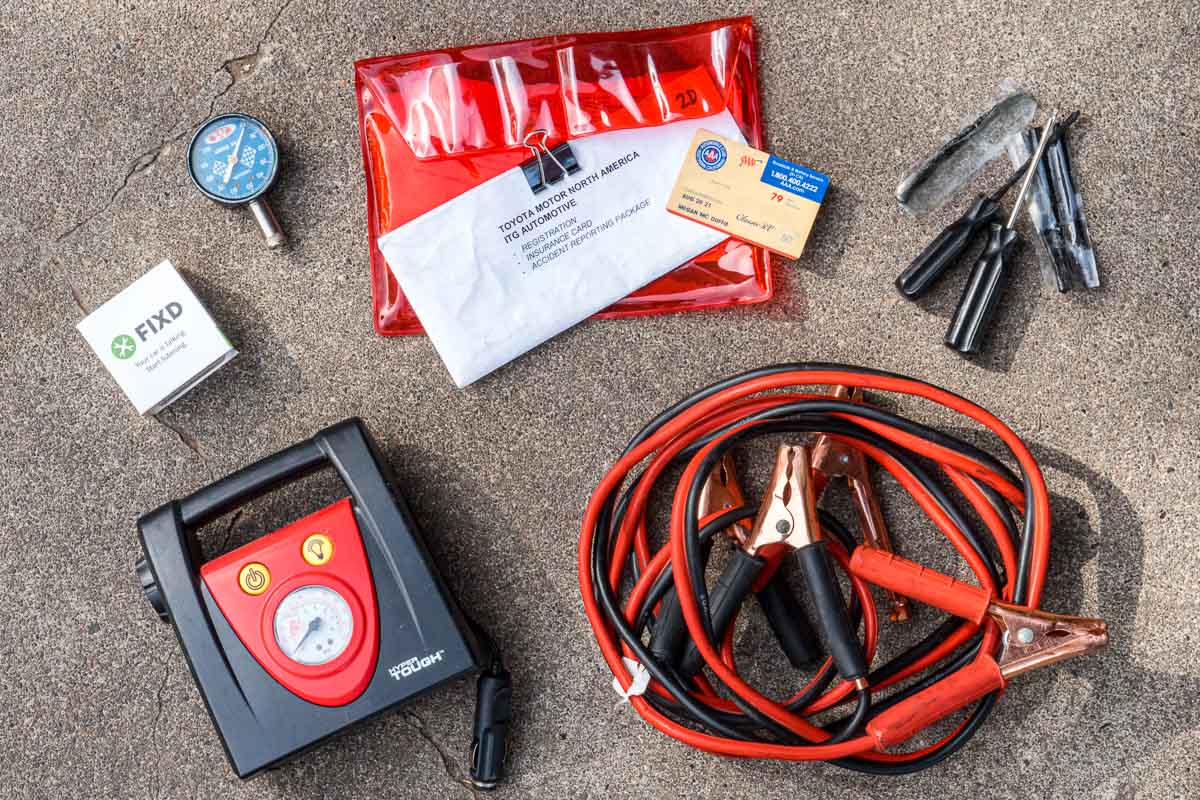
Vehicle essentials
These are the basic items you should keep in your car (regardless of whether or not you’re road-tripping!)
- License, registration, and insurance cards: Keep these together in an easily accessible place.
- Spare tire + tools: In addition to the tire, you’ll need a jack and a lug wrench. These are usually stored underneath the spare, but it wouldn’t hurt to double-check that they’re still there. Take five minutes to brush up on how to change a spare tire, too!
- Jumper cables: Forgot to turn off your lights before heading out to explore, and returned to a dead battery? Jumper cables to the rescue! If you’re going to be traveling on lesser-used roads, you might want to consider a jump start battery booster so you don’t have to wait for a friendly traveler to stop to help you.
- Tire pressure gauge: Many cars will have internal pressure monitoring systems, but having a manual tire pressure gauge is still nice so you can quickly and accurately check each tire.
- 12v tire pump: If you discover a slow leak in a tire, a 12v tire pump can fill the tire back up until you can resolve the problem.
- Tire patch kit: You can pick up a tire patch kit at any auto store or gas station. If you get a puncture in the middle of your tread (not near the sidewall) you can usually plug the hole yourself using a patch kit.
- Flashlight or headlamp: If you have car issues after dark, a flashlight or headlamp will help you see what you’re doing as you troubleshoot.
- Windshield sunshade: A sunshade makes a huge difference in keeping the interior of your car cooler while it’s parked.
- AAA membership: Hopefully you won’t have to use it, but the peace of mind that a AAA membership is absolutely invaluable. Unlock your car, jump your battery, or arrange a tow. As people whose campervan stopped running while parked on a desolate forest service road in Wyoming, we really can’t imagine road tripping without it.
- Fix’d device: This is an optional device that can be really helpful in diagnosing potential issues. This plugs into your car’s OBD-II port, and if the check engine light goes on, it will run and diagnose the code for you so you know what you’re dealing with (or know if you have to get to a mechanic pronto).
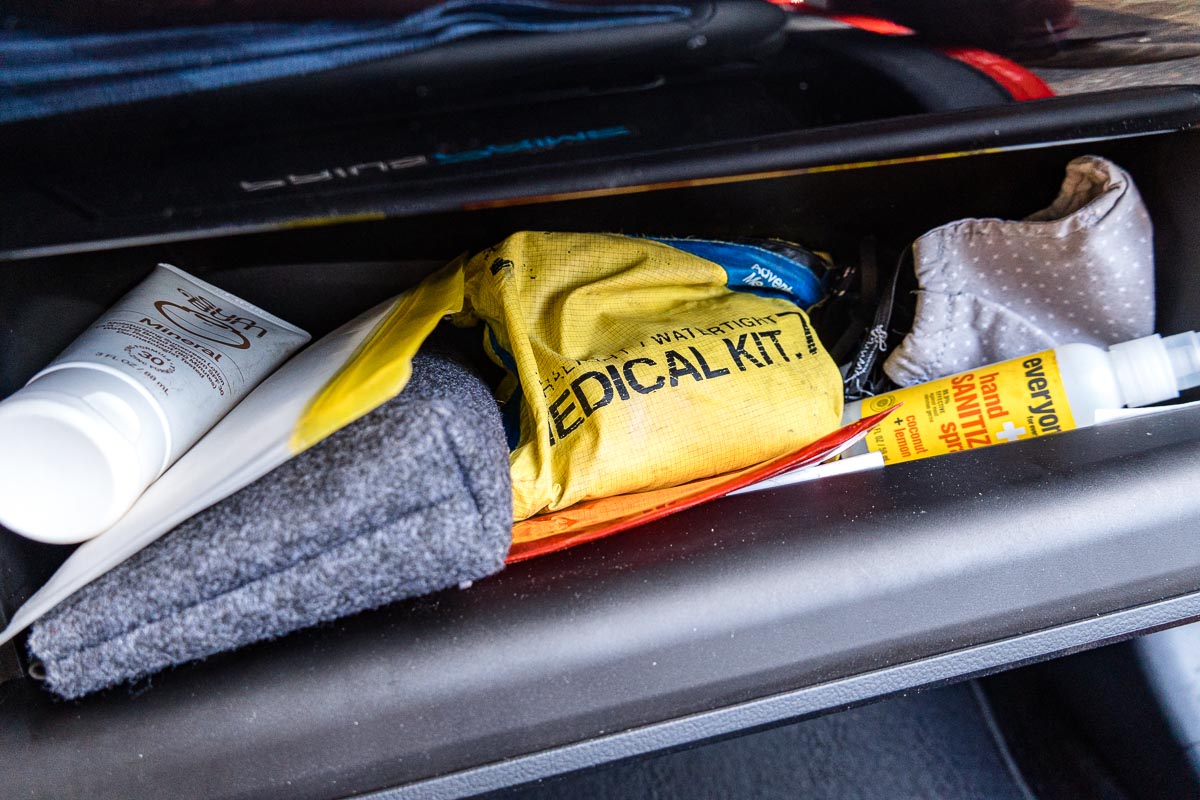
In the glove box
- Napkins: Invaluable for soaking up spills, wiping sticky hands, and any number of minor cleaning tasks.
- Extra TP (store in a ziplock bag): Just in case the one bathroom in a 50 mile radius is out of stock!
- Hand sanitizer
- Tissues: A small pack of tissues are nice to have in case allergies kick up or you start having deep conversations with your travel partner.
- Quarters: Spare change will come in handy if you encounter toll roads or bridges, old school parking meters, or need to run a load of laundry at a laundromat.
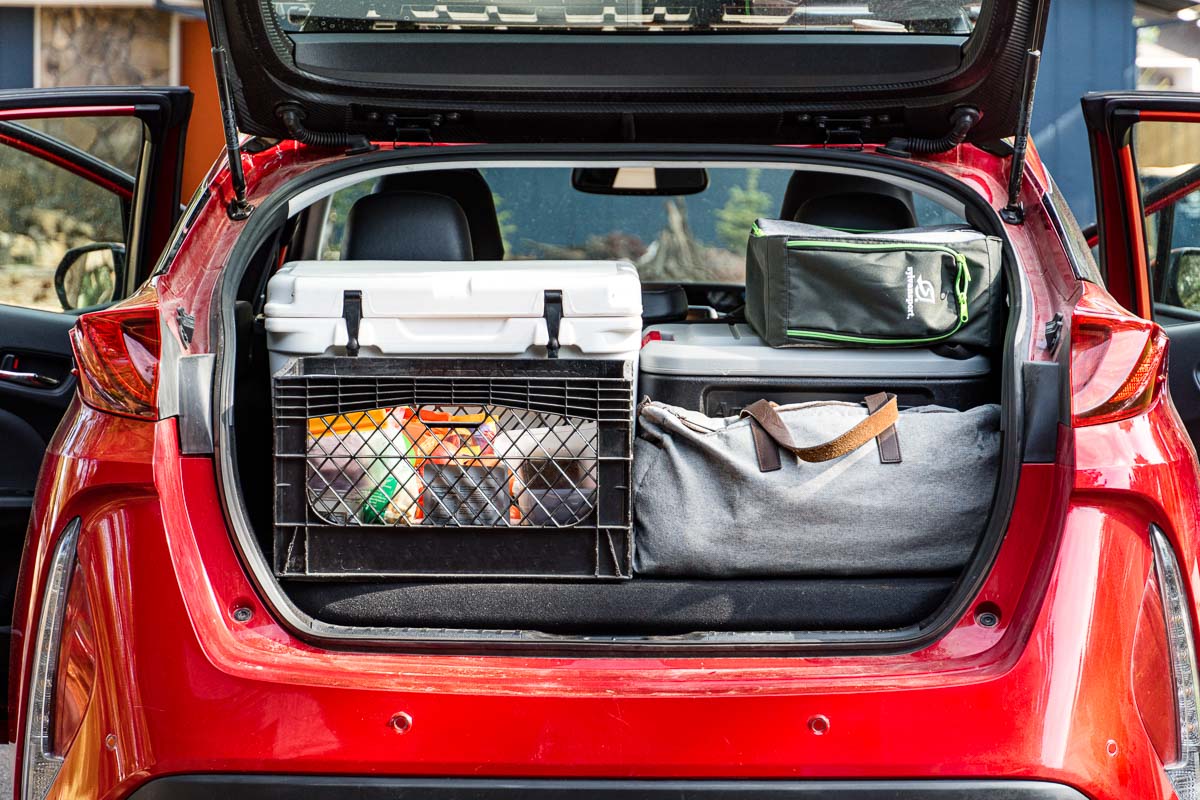
Organization
One of the keys to a comfortable road trip is to keep your vehicle and gear organized and tidy. You don’t want to have wrappers piling up in your drink holders, or have to dig through all your stuff every time you need to find something. You don’t need everything on this list—just pick and choose what will work best for you and the type of things on your road trip packing list.
- Trash bag/bin: A small trash bag or bin in an accessible location will really help in managing wrappers, fruit peels, receipts, etc. We like to use an empty protein powder container because the lid helps prevent spills and smells.
- Over the seat organizer: A small organizer that clips to the back of the front seats is a great way to keep things like maps, headlamps, snacks, kids’ car games, and charging cables organized. If you have kids, this larger organizer has an iPad sleeve.
- Packing cubes: We love packing cubes to keep our clothes organized. Tops go in one cube, shorts or pants in one, socks and underwear in another, and one for miscellaneous items like swimwear and other accessories. We each have our own color to make things easier to find.
- Duffel bag: Large soft-sided duffel bags like the Patagonia Black Hole Duffel or REI Road Tripper Duffel are perfect for storing your packing cubes and bulky items like jackets. These tend to be more space-efficient in your trunk than suitcases since they don’t have a rigid shape.
- Storage bins/action packers: Action packers are great for storing camping equipment, extra snacks, shoes, and other gear.
- Roof cargo box: Very optional, but we are big fans of storing as much of our gear in a roof cargo box as possible, especially items we won’t use daily. This helps free up room for backseat passengers and helps open up space in the car, making it feel a little less like driving a mobile storage unit.
- Day pack: Whether you plan on hiking or are sticking to urban adventures, a comfortable day pack is essential for carrying extra snacks, water bottles, layers, maps or guide books, etc.
- Laundry bag: Having a separate laundry bag means your clean clothes stay fresh in your duffel, and when you’re ready to do laundry, all you have to do is haul the bag in—no more sorting through all your clothes trying to figure out what is clean and what isn’t.
- Reusable grocery bag: Stash a few of these in your glove box or over-the-seat organizer for stops at the grocery store during your trip.
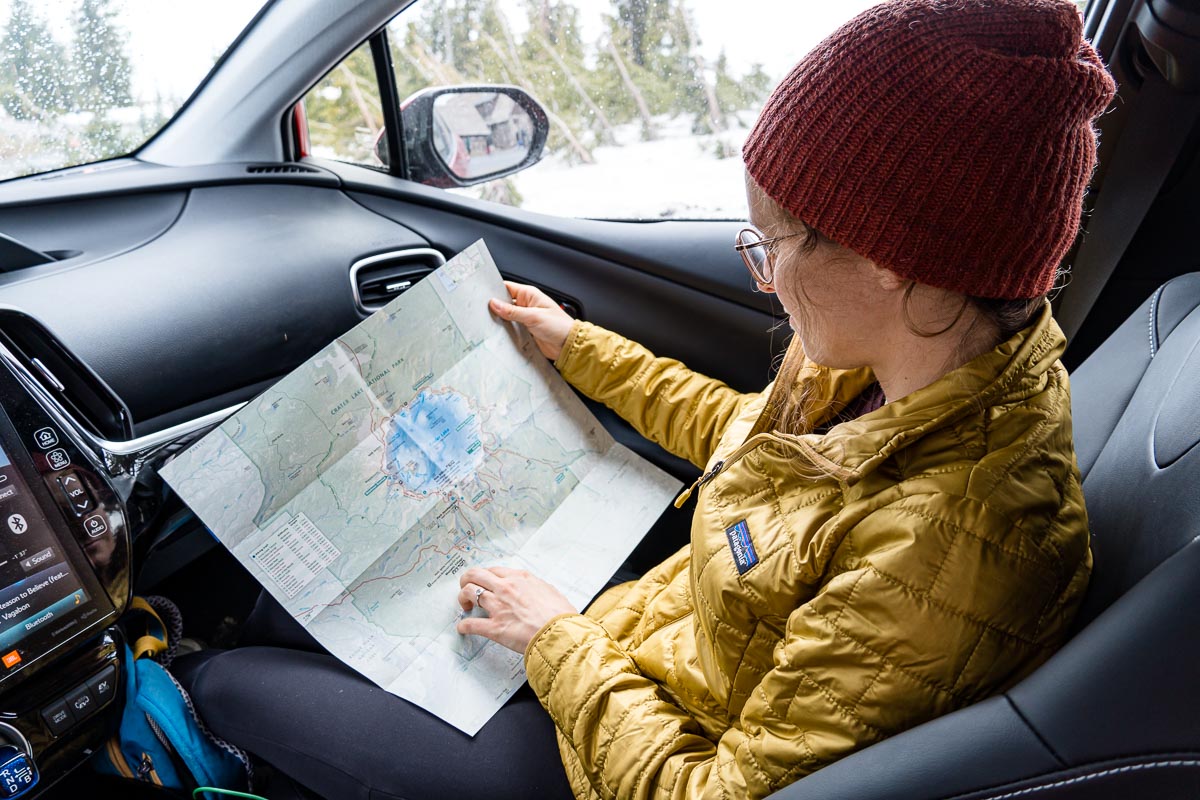
Navigation and electronics
We’ve lumped these categories into one since so much navigation is done electronically. However, cell service isn’t guaranteed in many rural areas of the US, so paper and offline navigation are still a road trip essential.
- Road atlas or paper maps: In case you find yourself turned around in an area without service, you should always be prepared with paper maps. We like the Benchmark Maps Road Atlases and have one for the states we frequently road trip through. Alternatively, you can pick up paper maps for free at AAA locations if you’re a member!
- Offline maps: Maps.me is an awesome offline map that is perfect for creating routes and turn-by-turn driving directions on the fly, even if you’re completely out of service. Download the area maps ahead of time and you’ll be able to access everything—including gas stations, public restrooms, hospitals, points of interest, etc. Before your trip, you can bookmark all your stops or things you’re interested in and create “Lists” so you can pull them up on the road.
- Hands-free phone mount: One of the best car accessories we have ever purchased is a hands-free phone mount. No more interpretive re-telling of the directions from the passenger to the driver. Just plug in the directions, mount the phone in your field of view, and you’re golden.
- USB Cords: We like to have dedicated USB cords that we leave in our vehicle. This way, we’re not shuttling them in and out and potentially forgetting to bring them.
- Small inverter: A 12v to 120v inverter can plug directly into a cigarette lighter and charge AC items like laptops and camera battery chargers. We’ve used this one for over six years of road trips!
- Apps: There seems to be an infinite number of apps that you can download for your road trip based on what your interests are! Here are some of our personal favorites for navigation and outdoor activities.
- GasBuddy: We use this app to find gas stations—it has user-aggregated price data, too, so we can save money by price comparing nearby stations.
- Maps.me: As mentioned above, this is our favorite offline map app for driving directions.
- Alltrails: Our favorite app for finding hiking trails. Sort by length, elevation gain, and difficulty.
- The Dyrt: A great app for finding campgrounds (complete with photos, reviews, and amenities). The PRO version allows you to access everything offline, has public land map layers, and includes a great trip planner tool.
- Seek by iNaturalist: Identify plants, animals, and birds, and tracks by using your camera or uploading a photo—the app will identify it for you!
- Merlin Bird ID: Enter bird features like size, color, and environment to generate a list of potential birds—includes sound recordings and photos for easier identification.
- The Outbound: A great app for finding all kinds of outdoor adventures.
- Nativelands: Identify the native tribes that traditionally lived in the area you’re traveling in.
- Sky Guide: Dynamic constellation, planet, and star identification.
- PlugShare: If you’re driving a plug-in hybrid like the Toyota Prius Prime, or an all-electric vehicle, this app will be invaluable in locating charge stations along your route.
Entertainment
Let’s face it: long stretches of driving can get monotonous, no matter how dynamic the scenery is. This is where some in-car entertainment becomes important.
Download everything to your phone ahead of time. It’s not a matter of if you’ll lose service, it’s when… And it is never at a convenient time. Once everything is downloaded, you’ll be able to access it any time.
We loved the CarPlay integration that the Toyota Prius Prime came with—it made it so easy to navigate between our music and podcasts while on the road!
- Audiobooks: Use Libby to download audiobooks from your public library for free, or use Everand which gives you an unlimited reading subscription for less than $10 a month (try it for 2 months free!)
- Spotify playlists: There are thousands of playlists to choose from, but we think the best place to start is with the “Soundtrack My Ride” feature which will build a custom playlist for you.
- Podcasts: We love bite-sized podcast episodes because they give us lots of new topics to talk about, in addition to (usually) learning something new. Here are some great road trip podcast recommendations from Conde Nast Traveler and AFAR.
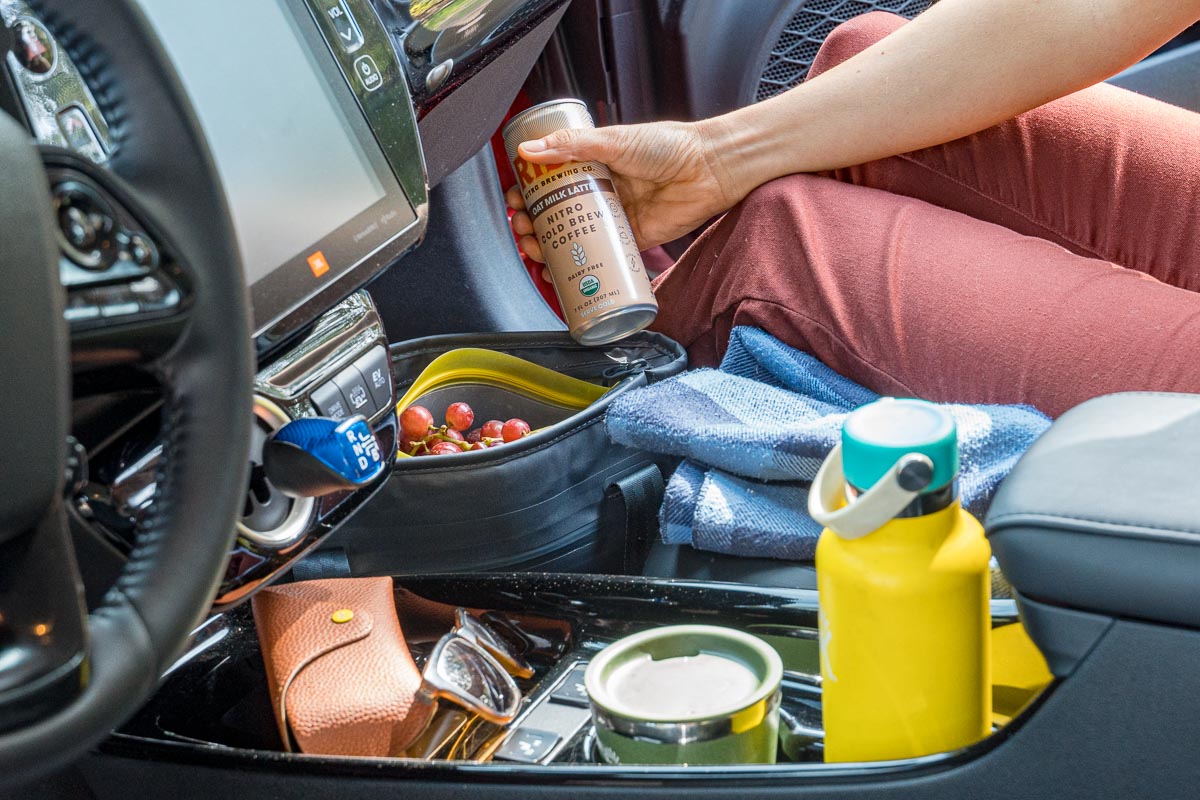
Comfort essentials for road trips
This is a list of little items we consider to be road trip essentials simply because they make the trip a little more comfortable and enjoyable.
- Snacks and drinks cooler: Keep a small cooler or insulated lunch tote within reach filled with any perishable road trip snacks and cold drinks.
- Coffee mug or tumbler: Make an extra cup of coffee in the morning and save it in an insulated coffee mug or tumbler. This will not only save money, but we bet you can make a much tastier cup of coffee than what you’ll find at a gas station!
- Water bottle: A reusable water bottle is absolutely essential for road trips! It’s so important to stay hydrated when traveling, and if you have water easily within reach, you’re more likely to sip throughout the day. Cycling through bottled water generates so much waste (of resources and your money), so pack along a durable, reusable bottle to fill up.
- Reusable utensils + straw: While we’re talking about reusables, we’d like to suggest throwing in a set of reusable utensils and drinking straws so you can ditch the plastic stuff when you grab takeout or stop at a food truck.
- Blankets/pillows: Catnaps in the passenger seat are so much more comfortable and restful if you have a pillow and a blanket. These are also nice to have to lay out on the grass at a rest stop for some shut-eye.
- Quick-dry towel/Turkish towel: Quick dry towels are a summer road trip necessity! Personally, we love jumping in lakes and rivers and a quick-dry towel is a way better option than regular bath towels. They are less likely to get mildewy and they’ll dry out before your next stop! A Turkish towel is similarly a great item and can double as a picnic blanket, sarong, or shawl.
- Sunglasses: Squinting into the sun as you drive is a recipe for fatigue, headaches, and it’s just plain bad for your eyes. A good pair of sunglasses with UV protection is a must-have for road trips. We love Sunski sunglasses, which come with a great warranty.
- First aid kit: Backroad Ramblers has a great post on putting together your own road trip first aid kit.
Toiletries and personal items
These are the self-care items that are on our road trip checklist to keep us feeling good throughout the trip.
- Sunscreen: While car side windows block UVB rays, they still allow UVA rays through—the ones that cause deep skin damage (but not sunburns), so it’s important to wear full-spectrum sunscreen, particularly on the side of your body next to the window.
- Lip balm: Prevent chapped lips by using lip balm, preferably one that has some SPF to it.
- Bug spray: You may not need it in the car, but bug spray is nice to have if you’ll be outdoors hiking or hanging out. This is a good travel-sized spray, and they have a DEET-free version as well.
- Prescription medications and OTC Med Kit: In addition to any prescription medications, put together a small over-the-counter med kit that includes painkillers for headaches and achy joints, Benadryl or Allegra for allergies, Imodium in case your lunch doesn’t sit well, etc.
- Car/Motion Sickness remedies: Either OTC or a non-medication option like ginger chews or those pressure point bands.
- Lotion
- Body wash/soap
- Wet wipes: These will come in handy in case you need a quick “bath” on the road (see the below section on showering during a road trip for more ideas).
- Toothbrush, toothpaste, and floss
- Wrinkle release spray: Your clothes are going to sit folded up in your luggage for days at a time, so having a travel-size wrinkle release spray can be super helpful on a road trip.
- Tide stain pen: Stains happen, and since you won’t be able to immediately throw your clothes into the wash, having a Tide stain remover pen can help prevent the stains from really setting in.
- Scrubba: Alright, this is totally optional, but this portable wash bag could be useful particularly if you’re traveling with kids and you want to be able to wash out stains and dirt from clothes without spending your time at the laundromat.
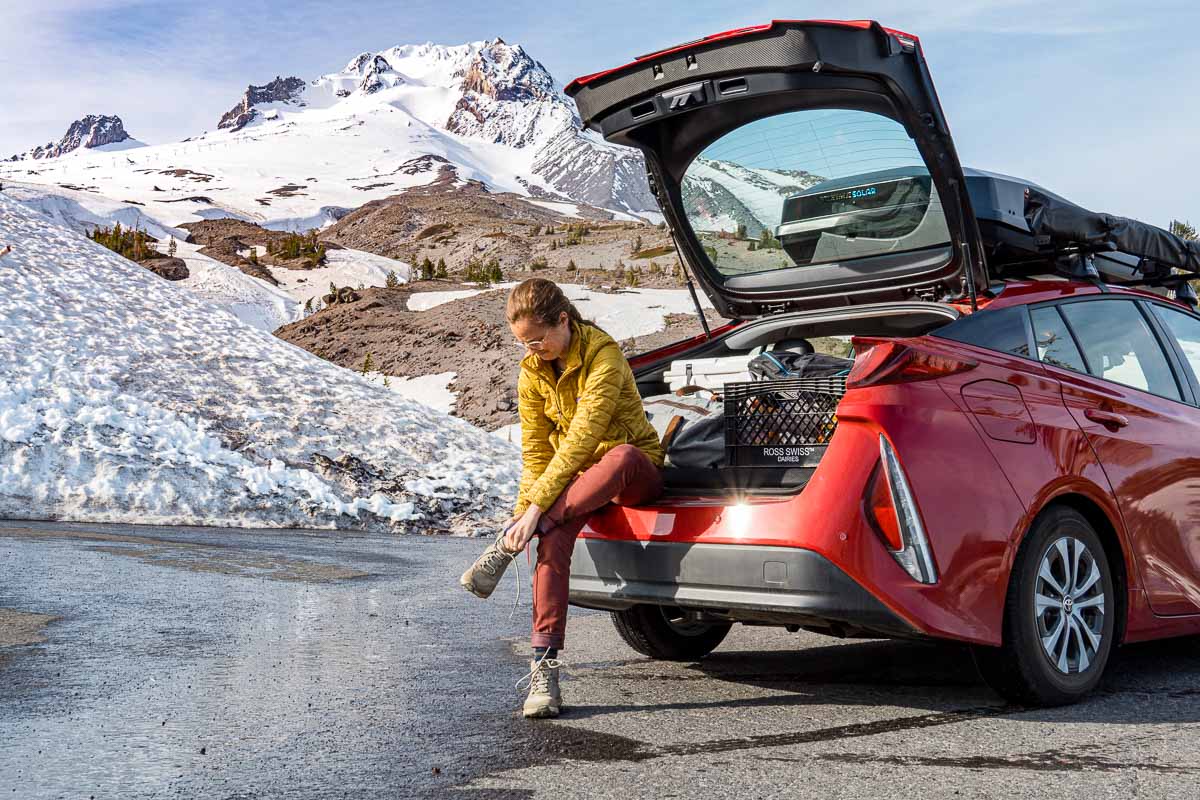
What to wear on a road trip
The clothing section of your road trip packing list is going to be pretty personalized based on where you’re going, the time of year and expected weather, and your personal style.
The key to packing clothing for a road trip is to balance comfort and versatility based on your planned activities, while keeping in mind the kind of weather you are likely to encounter.
Try to choose clothes that will serve multiple purposes, for instance, a warm jacket you can wear in the evening at your campsite but will still look good enough to walk around town on a brisk day. A good tip for pants is to choose ones that are good for hiking but that you’d also grab dinner in. prAna has a lot of good options for versatile pants.
Consider packing clothing that have helpful features while traveling such as antimicrobial or quick-drying fabrics, or UPF clothing that offer built-in sun protection.
Basic road trip packing list
- Short sleeve tops or tanks: one per day in the summer, or fewer in cooler temperatures
- Long sleeve tops: one or two in the summer, or more in cooler temperatures
- Pants, leggings, and shorts
- Activewear for hikes and outdoor exploring
- Warm jacket or sweater: extras if it’s going to be particularly cold
- Rain jacket
- Windbreaker or lightweight jacket
- Underwear
- Socks
- Comfortable walking shoes
- Hiking shoes, if necessary
- Swimsuit
- Hat (sun hat/warm beanie)
- Activity-specific items (rashguard, water shoes, etc)
- Sleepwear
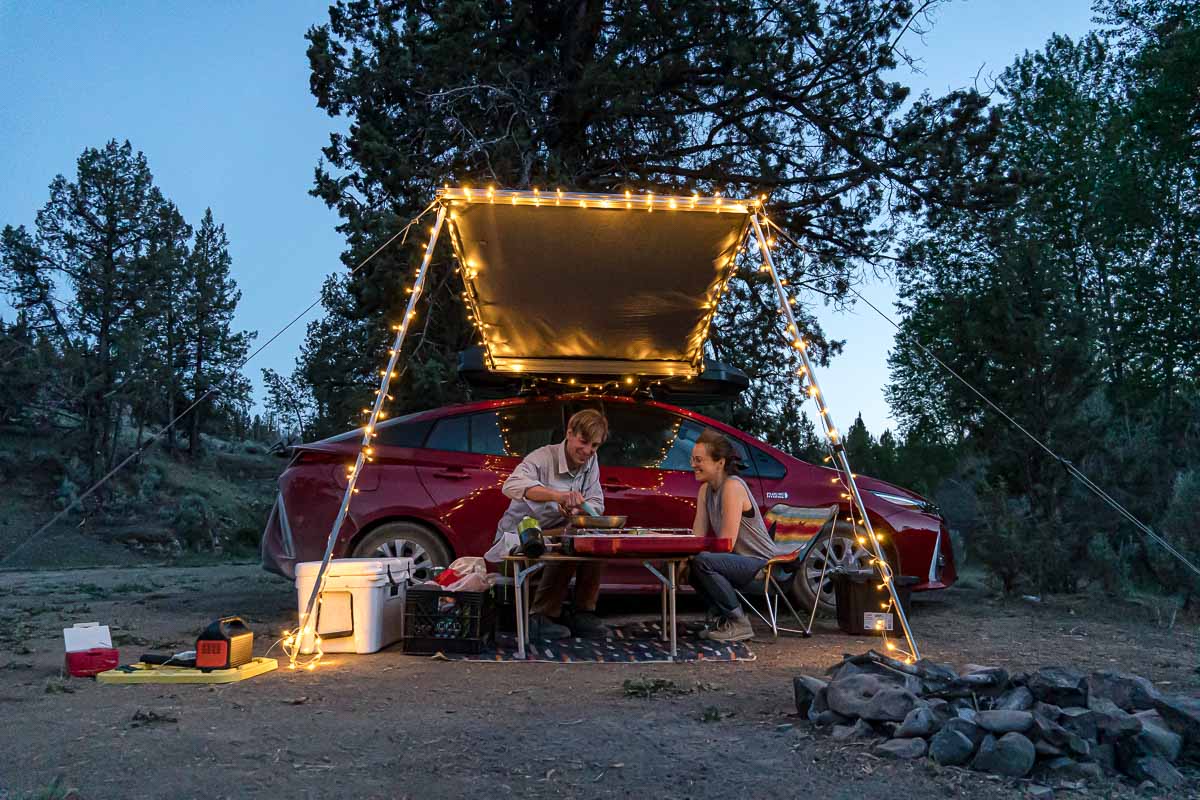
Camping basics
If you’ll be camping, there are a few additional things you’ll need to put on your road trip checklist. These are the bare essentials from our weekend camping checklist—we leave some of the “extras” behind knowing that we’re going to pack up and move frequently.
- Tent
- Sleeping mats
- Sleeping bags
- Pillow
- Camp chairs
- Folding camp table (optional)
- Cooler
- Camp stove and fuel
- Packable camp cookware set
- Spatula / spoon
- Knife and cutting board
- Plates, bowls, and utensils
- Camp coffee maker
- Collapsible dishwashing bucket (optional, depending on campsite selection)
- Sponge and campsuds
- Microfiber towel
- Bin to store kitchen items in
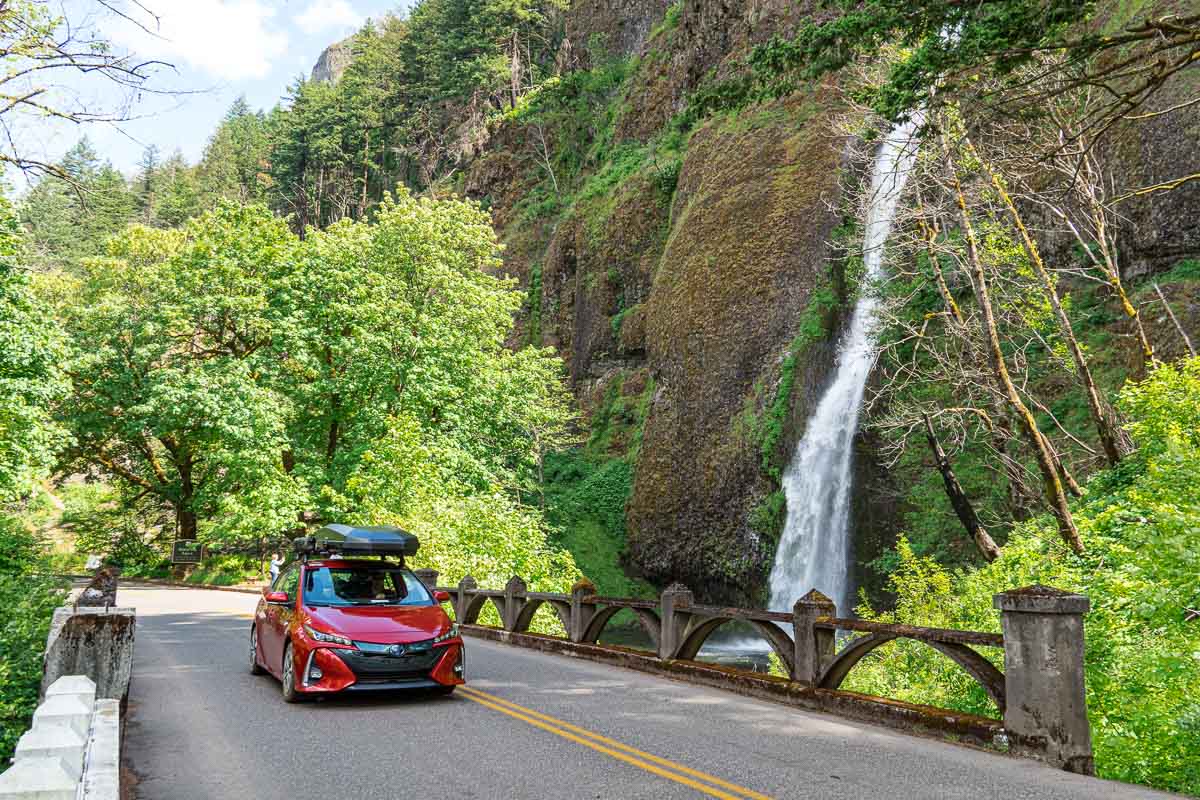
Essential road trip planning tips
Route planning
One of the allures of road-tripping is the freedom that comes with the open road. As soon as you get behind the wheel, you feel like everywhere is within your reach and you’re in a real-life “choose your own adventure” story. And while that feeling of freedom is real, it truly is a good idea to spend some time planning out an itinerary (however loose or detailed) before you leave.
At a minimum, it means that your co-pilot will have to spend less time researching what to do and where to go on the fly, and at best, it means you won’t have that post-trip regret of finding out you drove past the best waterfall in the state and you didn’t even know it.
We like to take a “planned spontaneity” philosophy when it comes to planning a road trip. After deciding on how long our road trip will be and choosing a general area for the trip, we start looking into the attractions and activities that we’d be interested in and start saving them to our Map.me bookmarks. Then, we can pull up the map that has all the points on it and see what our basic driving route might be, eliminating any real outlier stops.
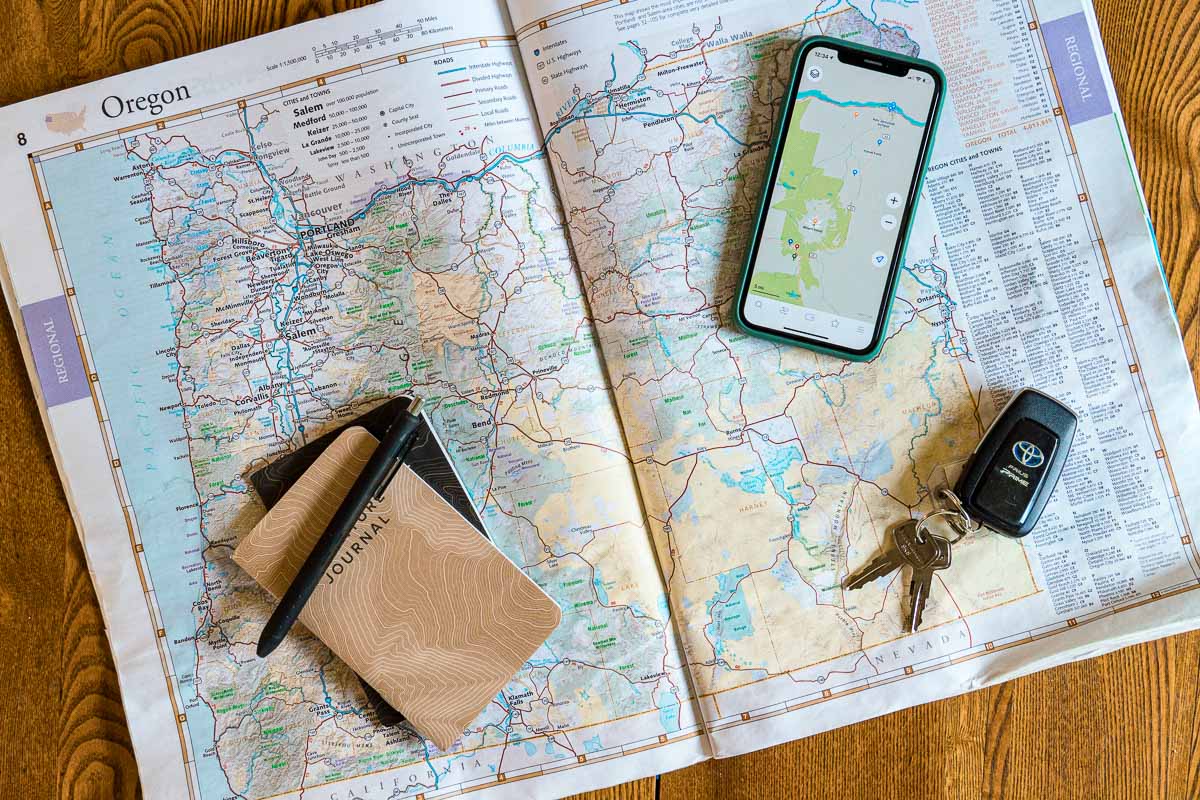
From there, we’ll spend a little more time thinking about how long we want to drive per day and the time needed to explore different locations. This is how we determine where we plan to sleep each night, and book campsites or hotels/Airbnbs.
Once we have a more solid route planned, we might add coffee shops or restaurants we want to check out or do a little more research into different points of interest.
That’s usually it. We end up with a rough timeline so we don’t get behind and a lot of ideas to choose from when we’re on the road, depending on how we’re feeling that day.
We like to budget extra time instead of planning down to the minute because the beauty of road trips is that even when you have a plan, you’re likely to stumble on fun, spur-of-the-moment stops, and you’ll want to have time to stop for those spontaneous adventures.
Make a budget
To an extent, a road trip can cost as much or as little as you have a budget for. If you make most of your own meals, get savvy at finding free camping, and choose free or inexpensive activities, you can really keep the costs of a road trip down. Or, you can book nights at Airbnbs, eat at local restaurants, and splurge on activities if it’s in your budget! We personally do a blend of both on most of our trips.
While you’re planning your trip, keep a total budget in mind, and then allocate it into different categories based on your priorities. Eating great food might be more important than where you lay your head at night, or perhaps you want to be able to book a fun adventure tour and are happy cooking at your campsite most nights.
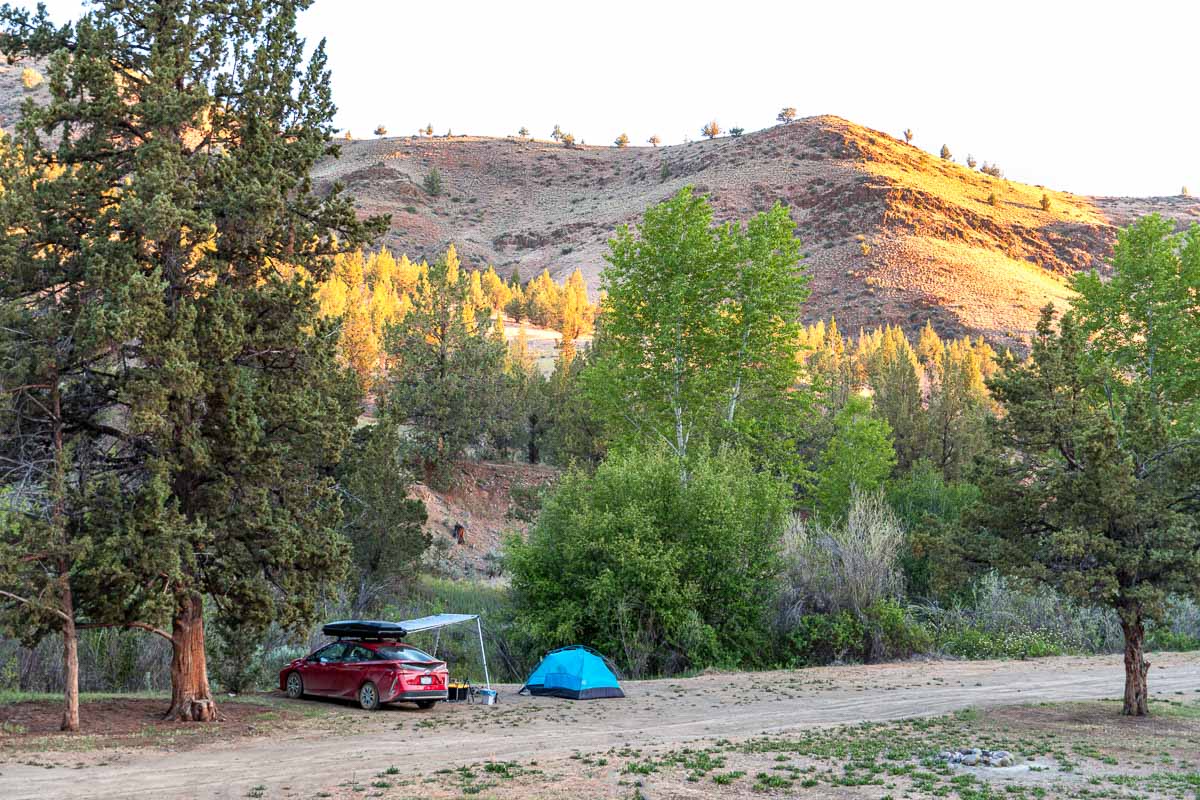
Where to sleep
On your road trip, you have several options for overnight accommodation. You can camp, stay at Airbnbs, hotels, or hostels, or stay with friends or family if they are along your route and willing to host you.
During busy travel periods or in popular destinations, you’ll probably want to book everything ahead of time. It sounds free and romantic to go where the wind blows and decide where you want to stay on the fly, but we’ve found that it adds unnecessary stress to our trips.
Campgrounds, in particular, are important to book in advance because they have limited space, and in many cases, if they’re full when you get there, there may not be many other camping options nearby.
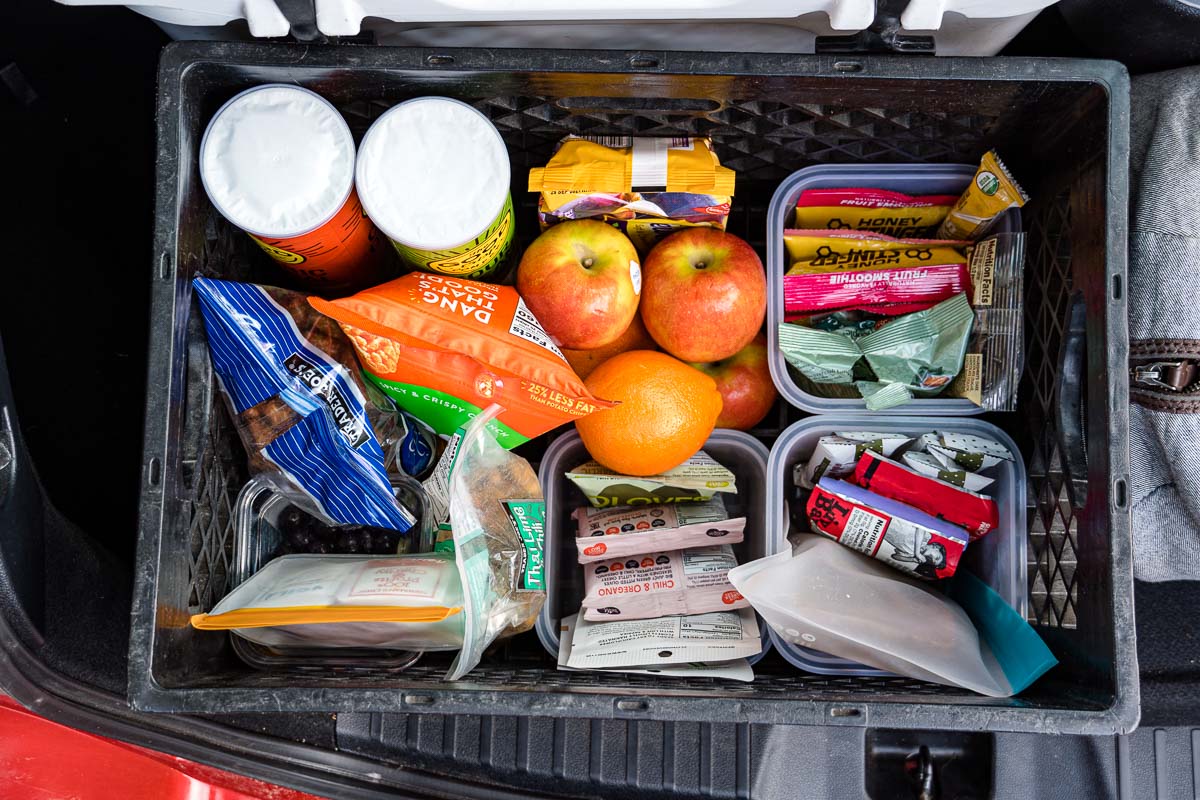
What to eat
Nothing ruins a road trip quite like a hangry passenger—or worse yet, a hangry driver! Failure to make plans for what and where you’re going to eat means you’re already halfway to Crankytown, so be sure to plan ahead and pack ALL THE SNACKS.
You can opt to eat out for all your meals and not have to worry about cooking at all, in which case, you may want to spend some time looking up interesting restaurants or food trucks along your route so you already have some to choose from when you roll into towns. If you’re camping or staying at Airbnbs or hostels with kitchens, you can make your own meals or pack to-go lunches.
Pack a small cooler or insulated tote with things like fresh veggies and hummus, cheese, sandwich supplies, and cold drinks like sparkling water, iced coffee, or kombucha so they are easy to access during the day.
Stash non-perishable road trip snacks like peanut butter-filled pretzels, nuts and trail mix, dried fruit, jerky, granola bars, and other snacks in your center console or in a bag so there’s always something ready when you start to feel hungry.
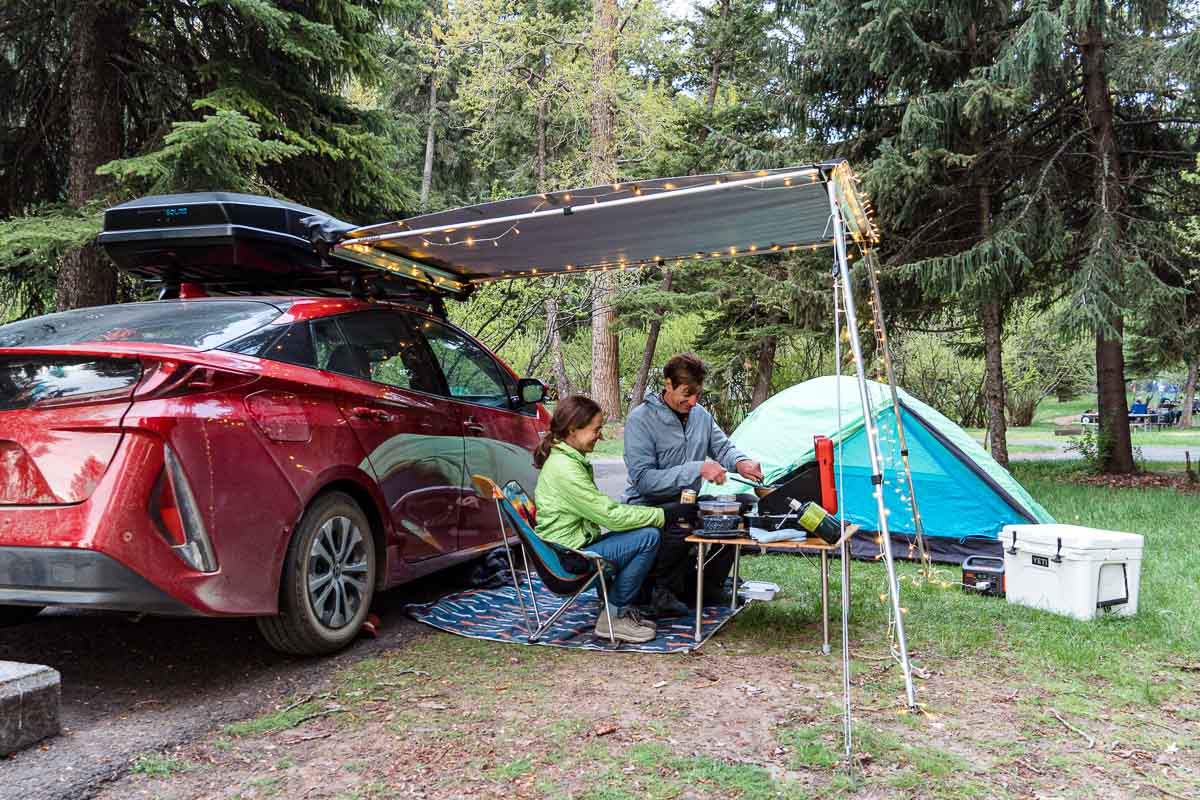
If you’re planning on making some of your own meals, it’s a good idea to keep things pretty simple so you can spend more time exploring and less time cooking. Here are some of our favorite road trip meals:
Breakfast
- Overnight oats with a bit of maple syrup and chopped fruit and nuts
- Made-ahead breakfast burritos warmed up on the camp stove
- Granola, milk, and fresh fruit
- Yogurt with berries and granola
Lunch
- “Charcuterie spread” of sliced cheese and salami, crackers or bread, olive packets, dried fruit, and nuts
- Sliced apple, almond butter, and honey sandwiches
- Avocado, tomato, and hummus sandwiches (perfect with some everything bagel seasoning!)
- Chicken or chickpea salad—make it at home and store it in your cooler. Serve in wraps, sandwiches, or on crackers.
Dinner
- Chickpea curry with rice or naan—all can be made ahead of time and reheated at the campsite
- Quick stir fry with noodles
- BBQ chicken quesadillas—you could cook and chop the chicken ahead of time for an even faster meal
- Tacos with store-bought salsa and avocado
- Pasta with fresh veggies and chickpeas or chicken sausage
- Here are a bunch more easy camping recipes and one pot meals
How to shower on a road trip
If you’re going to stay in hotels or at Airbnbs every night, you get to skip this section. But if you’re camping during your road trip, here are a few ideas (from most “civilized” to most “dirtbag”) of how to stay clean during your trip:
- Campgrounds you stay at: Check the amenities ahead of time, but many state and national park campgrounds will have shower facilities. Some will be included with your site fee, while others will require you to use quarters or buy shower tokens, so make sure you have some change on hand.
- Gyms/rec centers: If you have a gym membership to a chain with lots of locations, check to see if there are any along your route. The Planet Fitness Black Card Membership is famous among road-trippers because it’s $20 per month and gives you (and a guest) access to all their locations (and there are a TON of them). If you don’t already have a gym membership, many towns have city rec centers or Y’s where you can buy a day pass and take a shower.
- Sun shower: A sunshower is basically a portable water bag with a hose or spout that you can rinse off with. Leave it in the sun for a bit (or add hot water), and it’s an easy, cheap way to enjoy a warm rinse. We have used the Nemo Helio, which has a foot pump to pressurize the water (great if you want to do more than just have a quick rinse).
- Jump in a lake: But don’t use soap in it! If you’re spending time near lakes or rivers, a swim with a good ole hand scrub is one way to stay feeling clean. Just please don’t use soap in or near any water source. Even biodegradable soaps can pollute waterways since they need microorganisms to break down properly. If you want to use biodegradable soap, lather up and rinse off at least 200 feet away from the water’s edge
- Wet wipes: When all else fails, wipe down with a couple of wet wipes to get the day’s sweat and grime off you before bed.
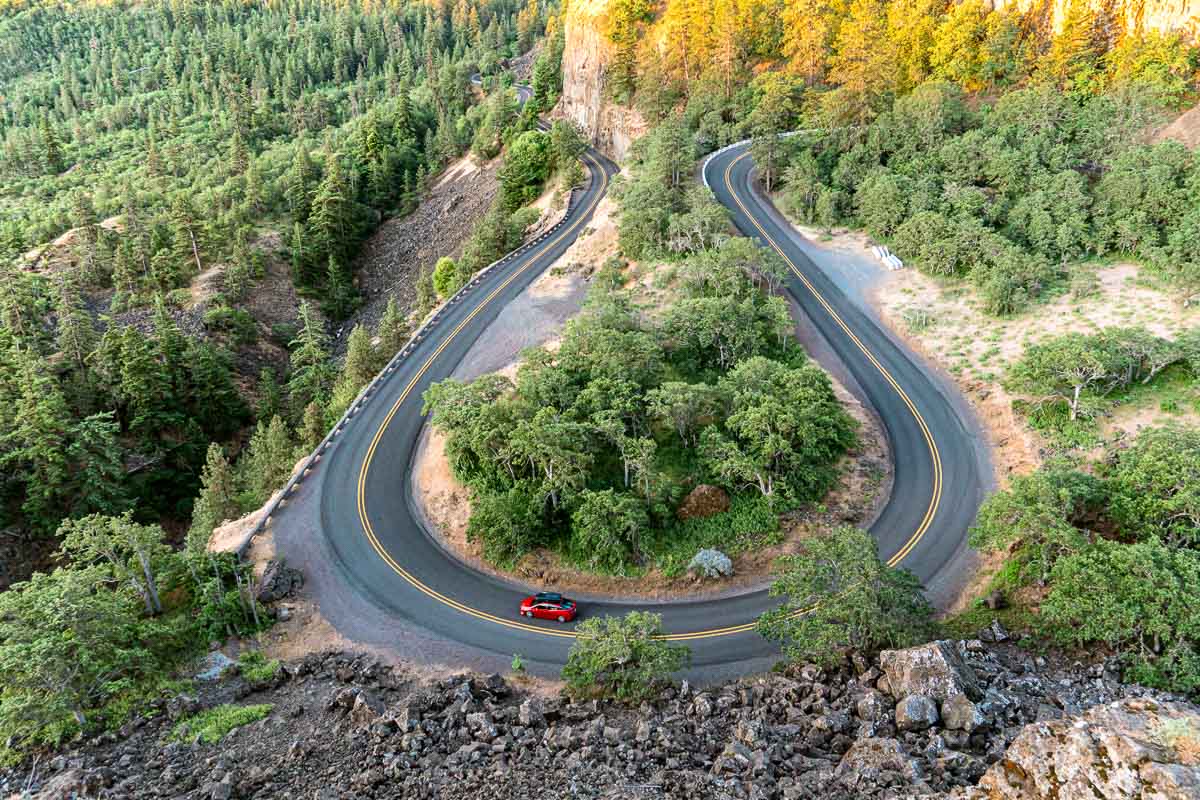
What are the best road trips in the USA?
Road trips are a quintessential US travel experience and there are SO many amazing routes to explore. Here are some of the best road trip itineraries on our website as well as others that we’ve done or are on our bucket list!
- 7 Wonders of Oregon Road Trip | Fresh Off The Grid
- Wild Wonderful West Virginia Road Trip | Fresh Off The Grid
- Gem Of The West Idaho Road Trip | Fresh Off The Grid
- Ultimate Teton & Yellowstone National Parks Road Trip | Bearfoot Theory
- Olympic National Park Road Trip | Bearfoot Theory
- 10-Day Utah National Parks Road Trip | Bearfoot Theory
- The Best California Road Trips | She Dreams of Alpine
- Northern California Road Trip Itinerary | The Mandagies
- 10-Day American Southwest Road Trips | The Mandagies
- 7-Day Glacier National Park Road Trip | The Mandagies
- Blue Ridge Mountains Road Trip | AFAR
Made possible by Toyota
We recently had the opportunity to take a Toyota Prius Prime on an epic Oregon road trip. We loved that it’s a plug-in hybrid, so we could charge at any number of charge stations along the way, but since it still has a fuel-efficient gas engine, we never had to worry about range. And, its large cargo space meant that we had plenty of room to pack all of our road trip essentials! Learn more about the Toyota Prius Prime here.

